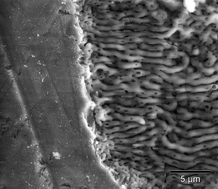This study critically evaluates the robustness of near infra red (NIR) femtosecond (fs) LA-ICP-MS as an analytical method, for as large an element suite as feasible and at concentrations ranging from many mg g−1 to 10's of ng g−1, for a range of silicate glass matrices. Sixty three major, minor and trace elements covering the mass range from Li to U in NIST (610, 612, and 614) and USGS basalt glass (BHVO-2, BCR-2G, and BIR-1) reference materials were determined by fs-LA-ICP-MS. NIST 612 was used as an external standard for calibration and 43Ca isotope was used as an internal standard to correct for matrix effect, drift, and the amount of ablated materials. Accurate element concentrations in NIST and USGS SRMs were determined with relative standard deviations (RSD) of less than 10% for most elements in all samples analyzed. The measured concentrations agree within 10% of the previously published values for most elements. Fractionation of almost all elements during extended periods of spot ablations was minimal based on calculated fractionation indices for NIST 610 and measured U/Pb ratios for all reference materials.

You have access to this article
 Please wait while we load your content...
Something went wrong. Try again?
Please wait while we load your content...
Something went wrong. Try again?


 Please wait while we load your content...
Please wait while we load your content...